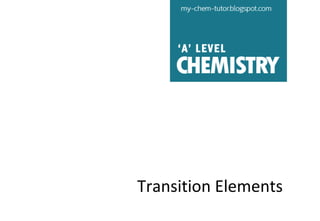
Transition Elements
- 2. Transition Elements The focus for Inorganic Chemistry (Gp II, VII, Transition Elements) is the trends for the physical and chemical properties of the elements.
- 3. Overview Transition Elements • definition • electronic configuration Physical Properties • atomic/ ionic radii • ionisation energy • mp Chemical Properties (4C) • catalysts - give examples of TE as homo/heterogeneous catalysts • complex ion - definition - ligand exchange • coordination compound • colour - account for colour using CFT
- 4. Transition Elements Definition A transition element is an element that can form at least one stable ion that has a partially filled d subshell. Common Errors: 1. … that has partially filled d orbitals 2. define in terms of characteristics of transition elements e.g. element that can form coloured complexes/ that can exhibit varying oxidation states.
- 5. Transition Elements Electronic Configuration • Fill up 4s before 3d. e.g. Ti: 1s2 2s2 2p6 3s2 3p6 3d2 4s2 • Remove from 4s before 3d. e.g. Ti+: 1s2 2s2 2p6 3s2 3p6 3d2 4s1 • Remember the exceptions (Cr, Cu)
- 6. Transition Elements Electronic Configuration For transition metal ions, write config for the metal atom first before removing from 4s. e.g. Fe3+ Fe :1s2 2s2 2p6 3s2 3p6 3d6 4s2 Fe3+ :1s2 2s2 2p6 3s2 3p6 3d5 Wrong: 1s2 2s2 2p6 3s2 3p6 3d3 4s2
- 7. Physical Properties Atomic Radii Note that in this chapter, there are 2 comparisons that we can make where the explanations are different: 1. transition element with main group metal in same Period 2. transition element with another transition element in the same Period. Students often get confused and give the wrong explanation.
- 8. Physical Properties A transition element has a smaller atomic radius than a main group metal in the same period e.g. Ca and Fe Explanation: - Fe has more protons than Ca nuclear charge of Fe is higher - Although Fe has more e–, the e– are added to the 3d orbitals which provide poor shielding - Increase in nuclear charge outweighs the increase in shielding effect effective nuclear charge is higher for Fe
- 9. Physical Properties Across the Period, the atomic radii of transition elements remains relatively constant. Explanation: - Across the Period, no. of protons increases, nuclear charge increases - e– are added to an inner d subshell, shielding effect increases significantly - Increase in nuclear charge is about equal to the increase in shielding effect effective nuclear charge remains constant
- 10. Q: For TM complexes e.g. [Cu(NH3)4(H2O)2]2+, how can the 3d and 4s accommodate all the lone pairs from the ligands? A: TM can also use the energetically accessible 4p orbitals for bonding. i.e. 3d, 4s and 4p orbitals are available for bonding 9 orbitals that can accommodate up to 18 e–
- 11. Q: Is TiO2+ a complex ion? How do I identify complex ions? A: A complex ion contains ligands that are datively bonded to the metal. Oxo ions (ions containing the metal and oxygen only) are not complex ions Example: TiO2+, VO2+, Cr2O72–, MnO4– Reason: oxygen is covalently bonded to the metal
- 12. Q: How do I identify ligands that are not datively bonded to the metal? 1. Erase all the bonds between the metal and the ligands. 2. Determine if the ligands are stable chemically i.e. stable : H2O, NH3 unstable : OH, Cl, O (incomplete octet) 3. Ligands that are stable form dative bonds to the metal 4. Ligands that are unstable form ionic/ covalent bonds to the metal
- 13. Q: How do I determine the charge on the metal in a complex? 1. Erase all the bonds between the metal and the ligands. 2. Determine if the ligands are stable chemically i.e. stable : H2O, NH3 unstable : OH, Cl, O (incomplete octet) 3. Ligands that are stable have no charge 4. For unstable ligands, determine the charge on it i.e. OH–, Cl–, O2– 5. Use algebraic method to determine charge on metal.
- 15. Q: How do I identify the donor atom in polyatomic ligands? A: Memorise. Some generalisations: Ligands containing COO–, use oxygen with –ve charge. For CO, CN–, SCN–, use the less electro–ve atom (in red). In research, the donor atom is determined through (i) quantum calculations and (ii) single crystal X-ray diffraction.
- 16. Q: For aq. metal ions, when do we write out the aqua ligands and when do we not? A: It is actually acceptable both ways i.e. Fe2+ (aq) ≡ [Fe(H2O)6]2+ Cu2+ (aq) ≡ [Cu(H2O)6]2+
- 17. The aqua ligands are only shown when they are directly involved in the reaction to emphasise their presence e.g. Hydrolysis of water [Fe(H2O)6]3+ + H2O [Fe(H2O)5(OH)]2+ + H3O+ Ligand exchange [Fe(H2O)6]3+ + 6NH3 [Fe(NH3)6]3+ + 6H2O
- 18. Q: Do strong ligands and strong field ligands mean the same thing? A: No. Strong ligands: - form strong bonds to the metal - can displace weaker ligands from their complexes (ligand exchange reactions)
- 19. Q: Do strong ligands and strong field ligands mean the same thing? A: No. Strong field ligands: - cause big crystal field splitting. However, ligands that can bind strongly to the metal usually causes bigger splitting.